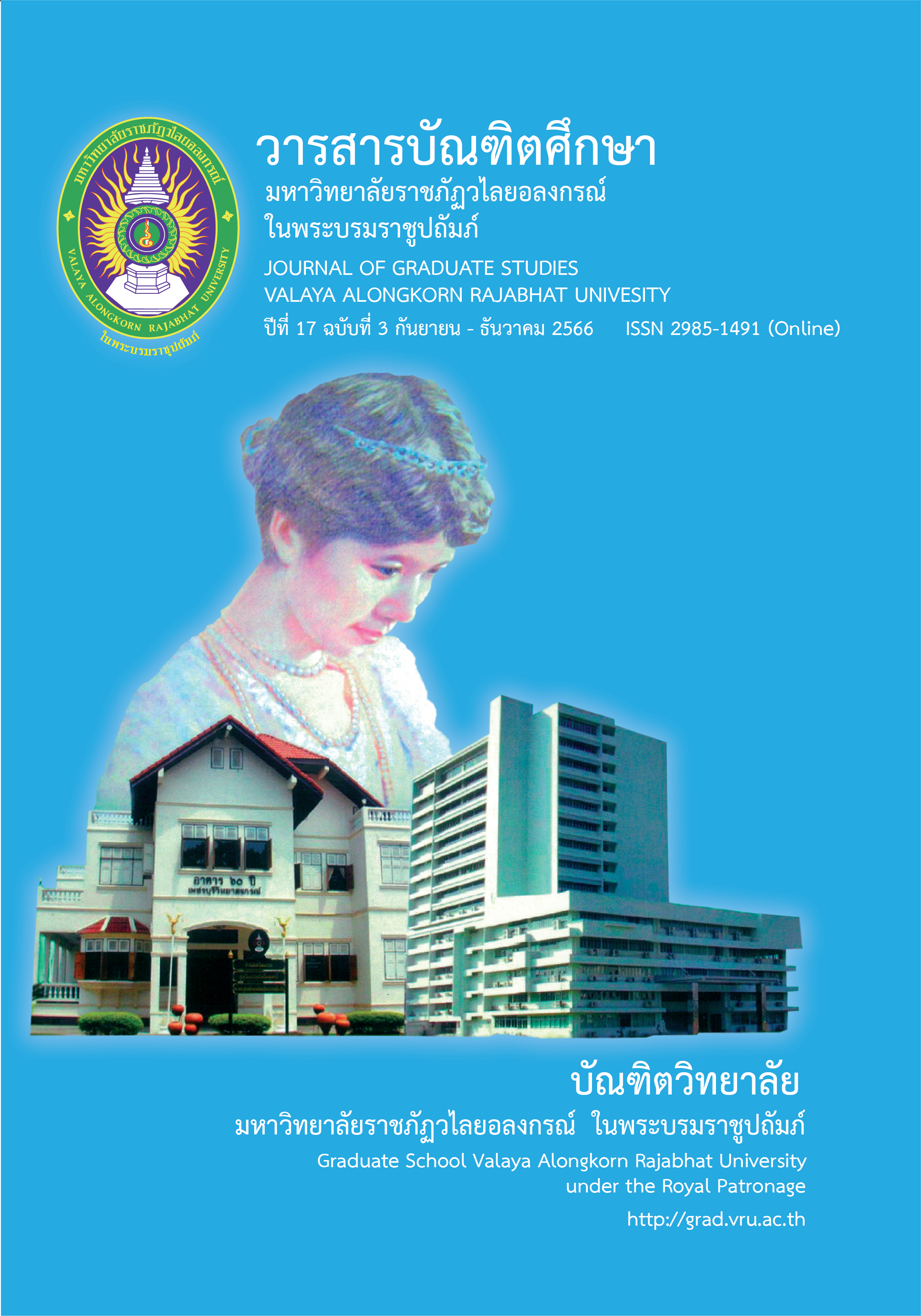SUSTAINABLE TOURISM MANAGEMENT GUIDELINES IN MOO SI COMMUNITY PAK CHONG DISTRICT NAKHON RATCHASIMA PROVINCE
Main Article Content
Abstract
This research aims to 1) study the context of tourism management in Moo Si community, 2) evaluate the potential of tourism management in Moo Si community, and 3) propose guidelines for sustainable tourism management in Moo Si community. This research was used mixed method that consisting of quantitative research methods and qualitative research methods. Qualitative research methods, the sample used in this research consisted of local people, representatives from government sector and representatives from tour operators 16 people by purposive selection. Quantitative research methods, data collection with questionnaires with the sample group 330 tourists traveling in the area by random sampling. Descriptive data were analyzed by descriptive statistics and content analyze.
The results revealed that 1) the context of tourism management in Moo Si community; The community has potential resources, but people in the community still lack knowledge and understanding of tourism management, participation in tourism management at a low level, 2) tourism management potential in Moo Si community was overall at a high level, and 3) sustainable tourism management guidelines in Moo Si community should be developed in another kind of tourism, tourism activity, marketing promotion, develop the competence of stakeholders, and cooperation network.
Article Details

This work is licensed under a Creative Commons Attribution-NonCommercial-NoDerivatives 4.0 International License.
บทความทุกเรื่องได้รับการตรวจความถูกต้องทางวิชาการโดยผู้ทรงคุณวุฒิ ทรรศนะและข้อคิดเห็นในบทความ Journal of Global of Perspectives in Humanities and Social Sciences (J-GPHSS) มิใช่เป็นทรรศนะและความคิดของผู้จัดทำจึงมิใช่ความรับผิดชอบของบัณฑิตวิทยาลัย มหาวิทยาลัยราชภัฏวไลยอลงกรณ์ ในพระบรมราชูปถัมภ์ กองบรรณาธิการไม่สงวนสิทธิ์การคัดลอก แต่ให้อ้างอิงแหล่งที่มา
References
Chamrat, S. (2017). Kānčhatkānrīankānsō̜n witthayāsāt 1. Nai Pra mūan sārachut wichasārattha Witthaya withīlæ tham ma chat khō̜ng witthayāsāt [Teaching and learning science 1. Foundations, methodologies, and nature of science education]. 5th ed. Nonthaburi: Sukhothai Thammathirat Open University.
Chaowakeratipong, N. (2019). Kānsongsœ̄m khwām sāmāt naikān sāngkhāʻ athibāichœ̄ng witthayāsāt khō̜ng phūrīan dūai kānsō̜nbǣpsư̄pso̜hākhwāmrū [Enhancing the ability in constructing scientific explanations of learners by using the inquiry teaching method]. STOU Journal. 12(1), 40–54.
Chutrakoolwong, A. (2014). phon khō̜ng kān rīan kānsō̜n bǣp sư̄p sō̜p dōi chai kham thām tām kān čhamnǣk praphēt watthuprasong thāngkān sưksā khō̜ngblūm thī mī tō̜ phon samrit thāngkān rīan fisik læ thaksa krabūankān thāng witthayāsāt khan phasomphasān khō̜ng nakrīan matthayommasưksā tō̜n plāi [Effects of inquiry instruction using questions based on bloom’s Taxonomy of educational objectives on physics learning achievement and integrated science process skills of upper secondary school students]. An Online Journal of Education. 9(1), 383-397. Retrieved from https://www.edu.chula.ac.th/ojed
Jamjai, O. (2014). Kān phat thanā khwām sāmāt naikān sāngkhamʻathibāichœ̄ng witthayāsāt khō̜ng nakrīan radap chanmatthayomsưksā pīthī Sām Dūairūp bǣp kānrīankānsō̜n bǣpsư̄pso̜ rūam kapkon withīkāntōyǣng [The development of grade 9 students’ ability in making scientific explanation using argumentation and inquiry approach]. Master of Education (Science Education). Kasetsart University.
Junping, J. (2012, September). kānphatthanā thaksa krabūankān thāng witthayāsāt khan būranākān khō̜ng nakrīan chan matthayommasưksā pī thī sō̜ng dōi kānčhatkān rīanrū bǣp sư̄pso̜ hākhwām rū [The development of an integrated science process skills of grade 8th students using the inquiry method]. In kān prachum sanœ̄ phonngā nawičhai radap bandit sưksā Mahāwitthayālai Sukhōthaithammāthirāt khrang thī sō̜ng [The 2nd STOU Graduate Research Conference]. (pp. 1-9). Nonthaburi: Sukhothai Thammathirat Open University.
Mcneill, K. L. & Krajcik, J. S. (2008). Scientific explanations: Characterizing and evaluating the effects of teachers' instructional practices on student learning. Journal of Research in Science Teaching. 45(1), 53–78.
Ministry of Education. (2017). Tūachīwatlæ sārakānrīanru ̄kǣnklāngklum sārakānrīanrūwitthayāsāt tām lak sūt kǣn klāng kānsưksānaphư̄nthān Phutthasakrāt (chabapkǣkhai) Sō̜ngphanhārō̜ihoksip [Indicators and learning areas in science, basic education, core curriculum (Revised) B.E. 2017]. Bangkok: Kurusapa Printing.
Osborne, J., Erduran, S., & Simon, S. (2004). Enhancing the quality argumentation in school science. Journal of Research in Science Teaching. 41(10), 994–1020.
Sampson, V. & Clark, D. V. (2009). The impact of collaboration on the outcomes of scientific argumentation. Journal of Science Education. 93, 448–484.
Sirithon, N. (2019). Kān čhat kānrīan rūbǣpsư̄pso̜thī khap khlư̄an dūaikon withīkāntōyǣng phư̄a phat thana ̄khwāmsāmāt naikānsāngkhamʻ athibāichœ̄ng witthayāsāt khō̜ngnakrīan chanmatthayomsưksāpī thī Sī Rư̄ang Rǣng Mūan lækotkānkhlư̄anthī [Implementing argument-driven inquiry approach for developing grade 10 students’ ability to make scientific explanation on the topic of force, mass, and law of motion]. Silpakorn University Journal. 39(1), 130–141.
The Institute for the Promotion of Teaching Science and Technology. (2017). Krō̜p khrōng sāng kān pra mœ̄n phon nakrīan khrōng kān PISA Sō̜ngphansiphā [PISA 2015 student assessment framework]. Retrieved from https://pisathailand.ipst.ac.th/pisa2018-fullreport/
The Institute for the Promotion of Teaching Science and Technology. (2021). Phon kān pramœ̄n PISA Sō̜ng phansip pǣt Kānʻān Khanitsāt læwitthayāsāt [PISA 2018 assessment framework: Key competencies in reading, mathematics and science]. Retrieved from https://pisathailand.ipst.ac.th/pisa-2015-framework/


